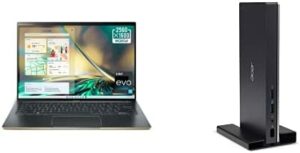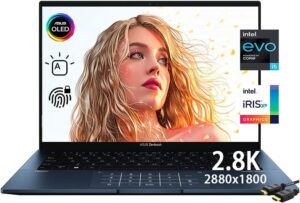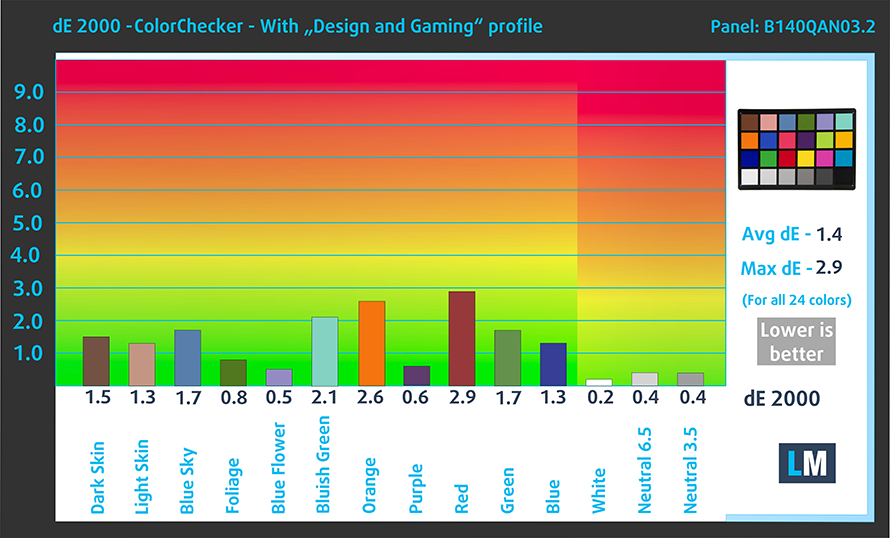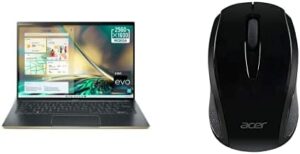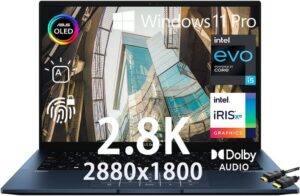[In-Depth Comparison] Acer Swift 5 (SF514-56T) vs ASUS Zenbook 14 OLED (UM3402) – Very similar, so it comes down to personal choice
 Smaller laptops have been getting better and better, coming with more performance and style. In a way, they have become very similar to smartphones, as there’s been a decent amount of premium machines that focus on the design and much as on the hardware, becoming an accessory that can also crunch numbers and be of helpful assistance to any working professional.
Smaller laptops have been getting better and better, coming with more performance and style. In a way, they have become very similar to smartphones, as there’s been a decent amount of premium machines that focus on the design and much as on the hardware, becoming an accessory that can also crunch numbers and be of helpful assistance to any working professional.
Today we have two such notebooks that both have striking designs and similar hardware options. The Acer Swift 5 (SF514-56T) is a 14-inch device that tries to be as light as a 13-inch while carrying a lot of performance with its Alder Lake P-series. Then we have the ASUS ZenBook 14 OLED (UM3402), which brings a high-res OLED panel that both Creators and avid movie fans will enjoy, providing excellent colors and brightness.
Today we’re presenting you with an in-depth comparison between the Acer Swift 5 (SF514-56T) and the ASUS Zenbook 14 OLED (UM3402).
Acer Swift 5 (SF514-56T): Full Specs / In-depth Review
ASUS Zenbook 14 OLED (UM3402): Full Specs / In-depth Review
Acer Swift 5 (SF514-56T) configurations:
ASUS Zenbook 14 OLED (UM3402) configurations:
Contents
Design and construction
For the 2022 model, Acer swaps out the magnesium-lithium alloy chassis for an aluminum one, which does increase the weight by 200 grams, so the laptop weighs 1.20 kg while remaining pretty thin, at 14.95 mm. The laptop looks and feels premium, as the lid and base are quite tough. Looks-wise, the Swift 5 has a beautiful Mist Green color, along with some gold accents, like the sides, the touchpad bezel, and the Acer logos on the base and lid.
On the side of the Zenbook 14 OLED, we also have an aluminum chassis with a dark blue color. ASUS also has a new alternate logo, which spreads all over the lid of the device. The laptop is both thicker and heavier, weighing 1.39 kg and having a profile of 16.9 mm. It’s quite durable as well, with no flex from both the lid and the base. Both laptops have lids that act as a lever, lifting up the backside to offer a better angle for typing, as well as more airflow to the cooling. On the other hand, the lid of the Swift 5 doesn’t open with one hand, while the one on the Zenbook 14 OLED does.
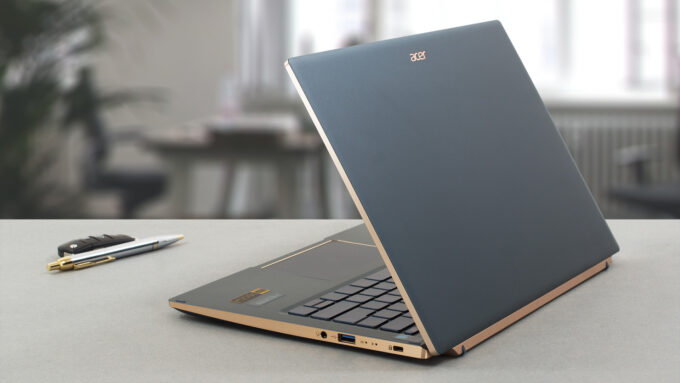

Keyboard and touchpad
Despite the thin chassis, the Swift 5 manages to deliver pretty decent key travel from its keyboard, as well as clicky and uniform feedback. The board also has a backlight. The touchpad is made from OceanGlass, an Acer-trademarked material, which uses ocean-bound plastic. It feels incredibly smooth, while the tracking and accuracy are great as well.
The keyboard on the Zenbook 14 has longer key travel, and the feedback is great as well. The Arrow keys are a bit small, but the same can be said about any other portable machine. The touchpad of the Zenbook carries a hidden NumPad, which can be accessed by pressing a button. There’s also a shortcut to the Calculator app. We really like it, both for its smoothness and the functionality that it brings.
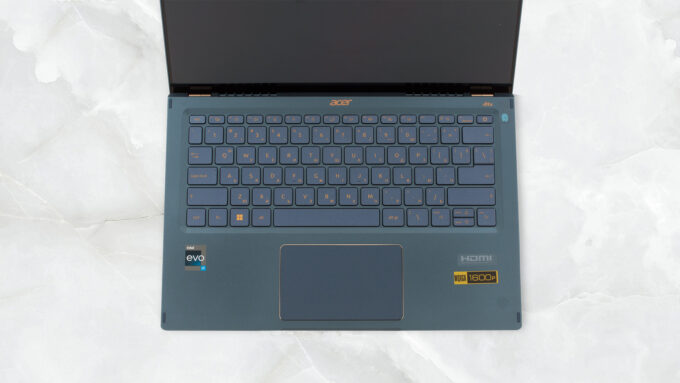
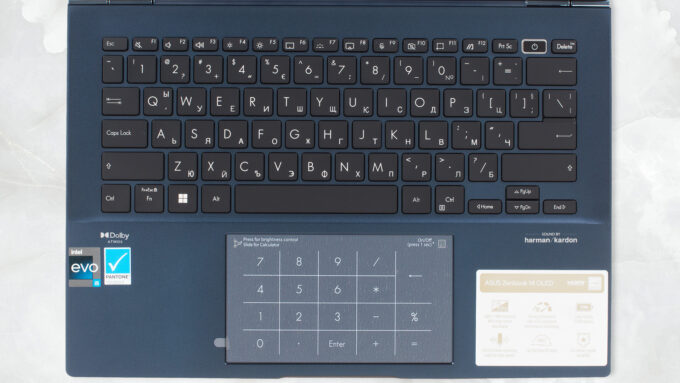
Ports
The Swift 5 comes with a total of two USB Type-A 3.2 (Gen. 1) ports, two Thunderbolt 4 ports, an HDMI 2.1 port, and a 3.5mm audio jack.


The Zenbook 14 OLED has one USB Type-A 3.2 (Gen. 2) port, an HDMI 2.0 port, a 3.5 mm audio jack, a Thunderbolt 4 port, and a MicroSD card reader.


Disassembly, and upgrade options
Both laptops offer up to 16GB of soldered LPDDR5 memory that works at 4800MHz. Storage-wise, there’s only one M.2 PCIe x4 slot for Gen 4 SSDs.

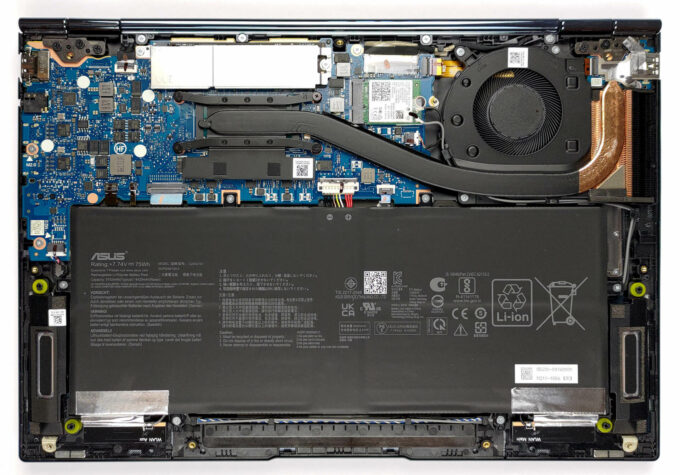
Spec sheet
Acer Swift 5 (SF514-56 / SF514-56T) series
- Dimensions
- 310.5 x 213.3 x 14.95 mm (12.22" x 8.40" x 0.59")
- Weight
- 1.20 kg (2.6 lbs)
- Price
- Not Available
ASUS Zenbook 14 OLED (UX3402) series
- Dimensions
- 313.6 x 220.6 x 16.9 mm (12.35" x 8.69" x 0.67")
- Weight
- 1.39 kg (3.1 lbs)
- Price
- Not Available
Display quality
The Acer Swift 5 comes with two IPS displays with a 16:10 aspect ratio. The base model has an FHD+ resolution, but you can upgrade to a QHD+ version as well. As for the Zenbook, there’s one 2.8K OLED panel with a 90Hz refresh rate. Regardless of which display of the Swift 5 you choose, the ASUS notebook will have a higher pixel density of 243 PPI, a pitch of 0,10 mm, and a Retina distance of 36 cm.

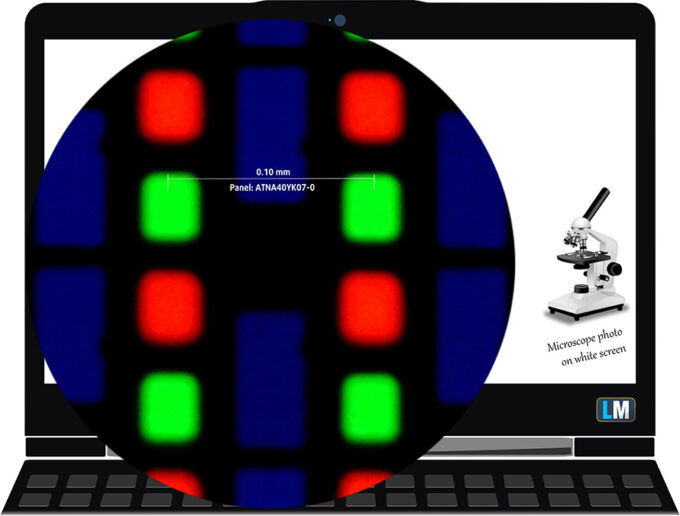
Both laptops have comfortable viewing angles. Here are images at 45 degrees to evaluate quality.


The display on the Swift 5 does reach higher max brightness of 536 nits, which is around 100 nits more than the ZenBook, whose display caps at 414 nits. However, the OLED panel of the ASUS laptop has an infinite contrast ratio, which means darker blacks.


Color coverage
To make sure we are on the same page, we would like to give you a little introduction to the sRGB color gamut and the Adobe RGB. To start, there’s the CIE 1976 Uniform Chromaticity Diagram that represents the visible specter of colors by the human eye, giving you a better perception of the color gamut coverage and the color accuracy.
Inside the black triangle, you will see the standard color gamut (sRGB) that is being used by millions of people on HDTV and on the web. As for the Adobe RGB, this is used in professional cameras, monitors, etc for printing. Basically, colors inside the black triangle are used by everyone and this is the essential part of the color quality and color accuracy of a mainstream notebook.
Still, we’ve included other color spaces like the famous DCI-P3 standard used by movie studios, as well as the digital UHD Rec.2020 standard. Rec.2020, however, is still a thing of the future and it’s difficult for today’s displays to cover that well. We’ve also included the so-called Michael Pointer gamut, or Pointer’s gamut, which represents the colors that naturally occur around us every day.
The yellow dotted line shows the color coverage of both the Acer Swift 5 (SF514-56T) and the ASUS Zenbook 14 OLED (UX3402), which both fully cover the sRGB color gamut, while the ZenBook also shows 100% DCI-P3 coverage.

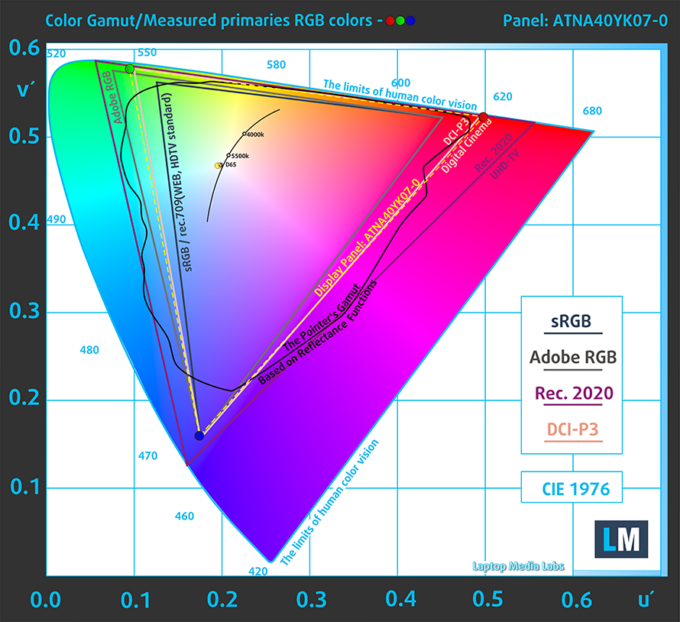
Color accuracy
We tested the accuracy of the display with 24 commonly used colors like light and dark human skin, blue sky, green grass, orange, etc. You can check out the results in factory condition and also, with the “Design and Gaming” profile.
Below you can check the results from the test of both laptops, with both the factory settings (left) and with our “Design and Gaming” profile applied (right).
The Swift 5’s display gets better color accuracy, with a dE value of 1.4. With that said, the Zenbook is still fairly accurate.
Acer Swift 5 (SF-514-56T)
ASUS Zenbook 14 OLED (UX3402)
Response time (Gaming capabilities)
We test the reaction time of the pixels with the usual “black-to-white” and “white-to-black” method from 10% to 90% and vice versa.
While the Zenbook 14 OLED is nowhere near a gaming laptop, it has a wickedly quick Fall + Rise time of 1.8 ms.
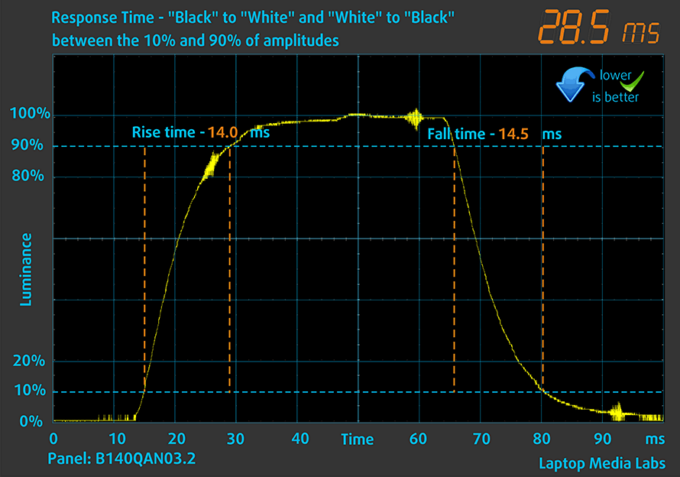
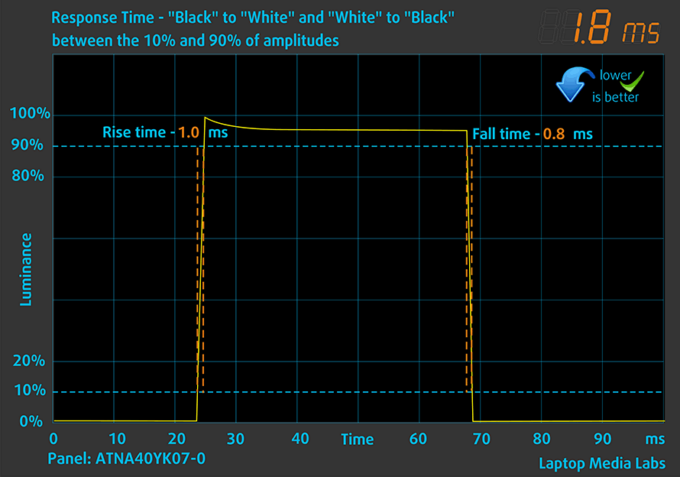
Health Impact – PWM / Blue light
PWM – Screen flickering
Pulse-width modulation (PWM) is an easy way to control monitor brightness. When you lower the brightness, the light intensity of the backlight is not lowered, but instead turned off and on by the electronics with a frequency indistinguishable to the human eye. In these light impulses, the light/no-light time ratio varies, while brightness remains unchanged, which is harmful to your eyes. You can read more about that in our dedicated article on PWM.
The ASUS Zenbook shows PWM usage up to 95 nits, after which we see small pulsations which aren’t dangerous.


Blue light emissions
Installing our Health-Guard profile not only eliminates PWM but also reduces the harmful Blue Light emissions while keeping the colors of the screen perceptually accurate. If you’re not familiar with the Blue light, the TL;DR version is – emissions that negatively affect your eyes, skin, and your whole body. You can find more information about that in our dedicated article on Blue Light.
Buy our profiles
Acer Swift 5 (SF514-56T) 14″ WQXGA IPS AUO B140QAN03.2 (AUODD9E): Buy our profiles
ASUS Zenbook 14 OLED (UX3402) a 14.0″ Samsung ATNA40YK07-0 (SDC4171) (2880 x 1800p) OLED: Buy our profiles
Sound
Both laptops produce good audio, however, the setup of the Swift 5 has some deviations in the higher frequencies.
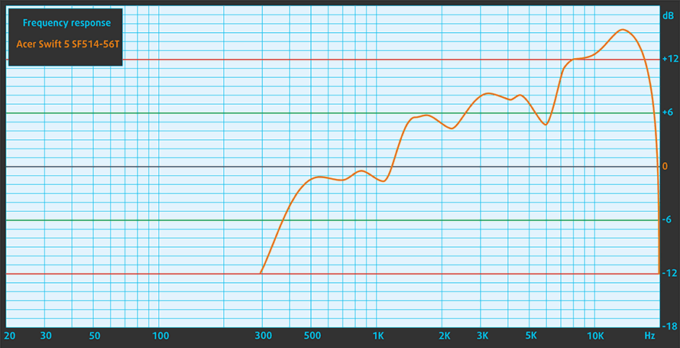

Battery
Battery life is pretty similar, albeit the Zenbook does have a larger 75Wh unit. Still, the Swift 5 comes ahead in Web browsing, lasting for an extra 9 minutes, while the ASUS device lasts for an extra hour and 19 minutes of video playback.
In order to simulate real-life conditions, we used our own script for automatic web browsing through over 70 websites.
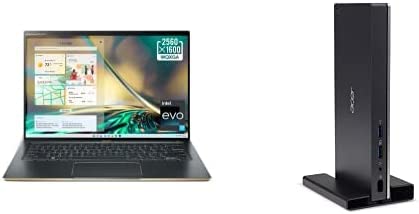
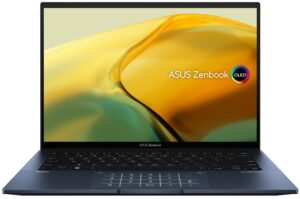
For every test like this, we use the same video in HD.


Performance
Both laptops are powered by the Alder Lake P-series, with either the Core i5-1240P or the Core i7-1260P. As for graphics, there’s only the Iris Xe Graphics G7 with either 80 or 96 Execution units, depending on if you go for a Core i5 or a Core i7 chip.
CPU benchmarks
Here we tested the Core i7-1260P inside the Swift 5 and the Core i5-1240P inside the Zenbook 14 OLED. Both CPUs have the same core and thread count, while the Core i7 has 6MB of extra cache and slightly higher speeds. The Core i7 has a 9% higher score in 3D Rendering, while also being slightly quicker in Photoshop, but only by about 0.3 seconds.
Results are from the Cinebench R23 CPU test (the higher the score, the better)
Results are from our Photoshop benchmark test (the lower the score, the better)
GPU benchmarks
Thanks to the higher EU count, the iGPU inside the Core i7 is also significantly stronger, scoring 28%, 23%, and 19% in 3DMark Time Spy, Fire Strike, and Wild Life benchmarks respectively, while also being 23% faster in Unigine Superposition.
Results are from the 3DMark: Time Spy (Graphics) benchmark (higher the score, the better)
Results are from the 3DMark: Fire Strike (Graphics) benchmark (higher the score, the better)
Results are from the 3DMark: Wild Life benchmark (higher the score, the better)
Results are from the Unigine Superposition benchmark (higher the score, the better)
Gaming tests
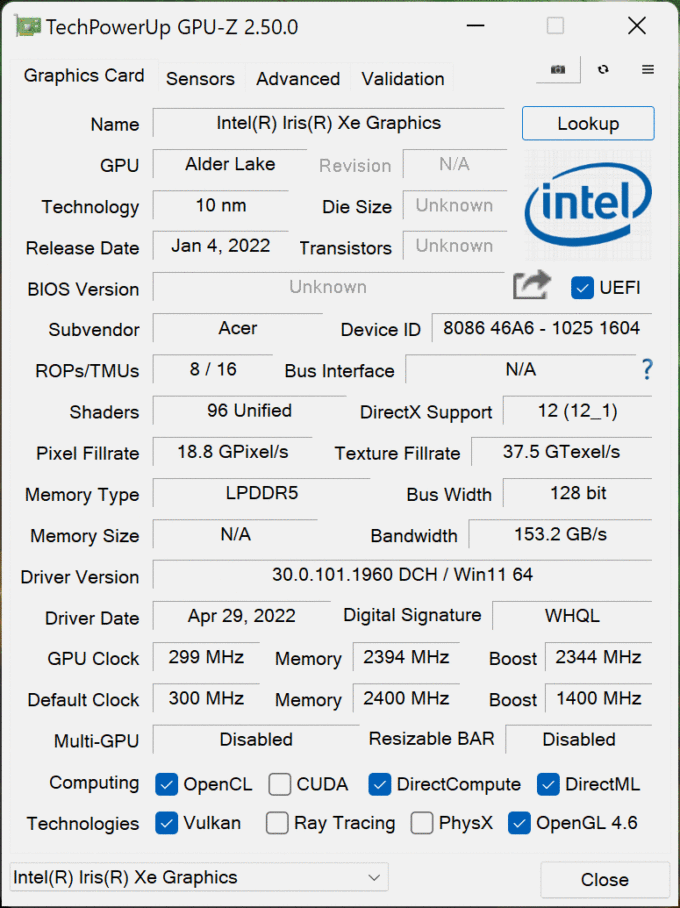
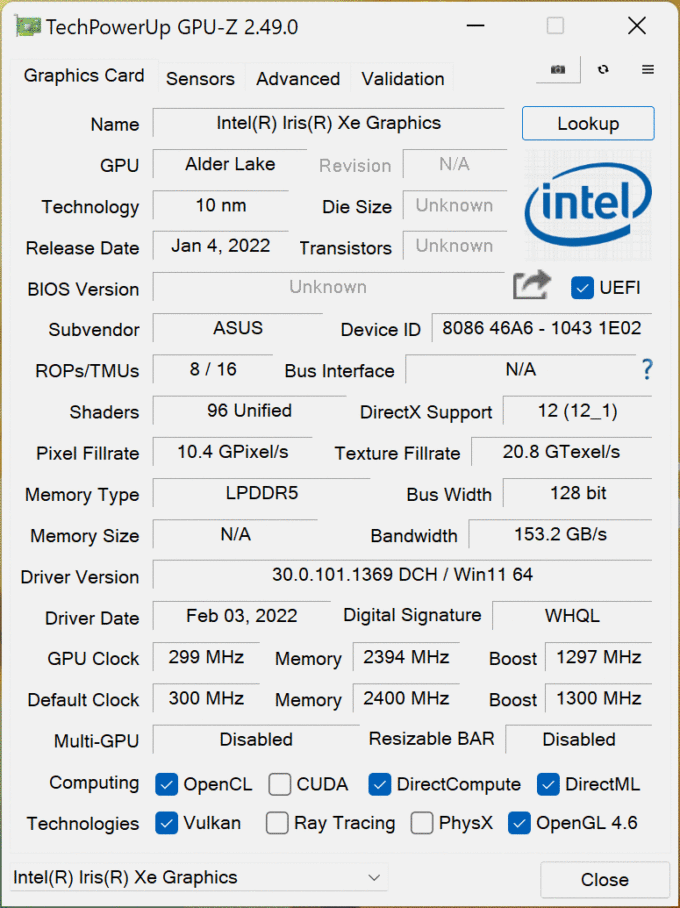

| CS:GO | HD 1080p, Low (Check settings) | HD 1080p, Medium (Check settings) | HD 1080p, MAX (Check settings) |
|---|---|---|---|
| Acer Swift 5 (SF514-56T) – Iris Xe Graphics G7 (96EU) | 176 fps (+18%) | 137 fps (+40%) | 87 fps (+34%) |
| ASUS Zenbook 14 OLED (UX3402) – Iris Xe Graphics G7 (80EU) | 149 fps | 98 fps | 65 fps |

| DOTA 2 | HD 1080p, Low (Check settings) | HD 1080p, Normal (Check settings) | HD 1080p, High (Check settings) |
|---|---|---|---|
| Acer Swift 5 (SF514-56T) – Iris Xe Graphics G7 (96EU) | 159 fps (+4%) | 108 fps (+2%) | 66 fps (+10%) |
| ASUS Zenbook 14 OLED (UX3402) – Iris Xe Graphics G7 (80EU) | 153 fps | 106 fps | 60 fps |
Temperatures and comfort
The Swift 5 definitely brings a better cooling setup, with two heat pipes and two fans, whereas the Zenbook has one pipe and one fan.

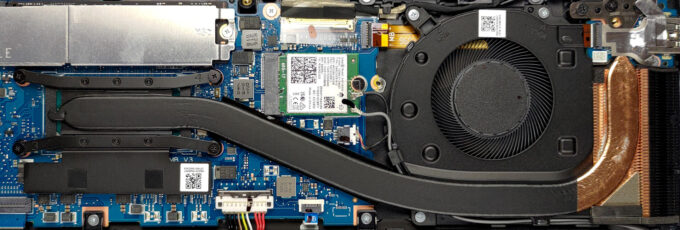
Max CPU load
| Intel Core i7-1260P (28W TDP) | 0:02 – 0:10 sec | 0:15 – 0:30 sec | 10:00 – 15:00 min |
|---|---|---|---|
| Acer Swift 5 (SF514-56T) | 3.23 GHz @ 2.58 GHz @ 82°C @ 61W | 2.35 GHz @ 1.90 GHz @ 86°C @ 42W | 2.27 GHz @ 1.73 GHz @ 72°C @ 30W |
| Intel Core i5-1240P (28W TDP) | 0:02 – 0:10 sec | 0:15 – 0:30 sec | 10:00 – 15:00 min |
|---|---|---|---|
| ASUS Zenbook 14 OLED (UX3402) | 2.47 GHz @ 2.17 GHz @ 65°C @ 43W | 2.44 GHz @ 2.17 GHz @ 83°C @ 43W | 1.96 GHz @ 1.75 GHz @ 75°C @ 30W |
While both laptops manage to sustain 30W in long runs, the Swift 3 runs at slightly higher speeds at the end, while being quite quicker, in the beginning, going as high as 3.23 GHz. We generally don’t compare different CPUs in stress tests, but since these two are so similar, we’re willing to make an exception.
Comfort during full load
As for comfort, both laptops hover at 40-something degrees at max load, while noise is definitely higher with the Swift 5, thanks to the second fan.
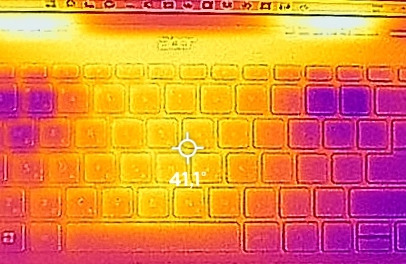

Verdict
Both of these laptops are very good in what they do: offer a premium computing experience, while being as light and as powerful as possible. Thanks to Intel’s introduction of the Alder Lake P-series, we can get amazing devices for engineers and creative professionals, who want to do work on the go. To sum both of these laptops up, the Swift 5 has a lighter and thinner body. Both devices bring great input devices, with the Zenbook also bringing NumPad functionality inside its touchpad.
The port selection is similar as well, but the Zenbook offers a MicroSD card reader, which is massive for photographers. The OLED panel of the ASUS device has great colors, with 100% DCI-P3 coverage and deep black colors, however, the QHD+ display of the Swift 5 gets much brighter and doesn’t use PWM at all. It also gets more accurate once we apply our Design and Gaming profile. Battery life is slightly better on the Zenbook, thanks to the larger 75Wh unit, while performance is higher on the Swift 5, due to the Core i7-1260P’s appearance.
Lastly, in terms of cooling, the Swift 5 brings a more robust cooling solution, but it doesn’t seem to show any extra improvement in long runs. If you feel stuck between the two devices and wonder what to get, just check out what the pricing is in your region, and base your decision on that.
Why choose the Acer Swift 5 (SF514-56T)?
- Lighter and thinner chassis
- The display is brighter and doesn’t use PWM
Why choose the ASUS Zenbook 14 OLED (UX3402)?
- Way faster display
- Has a MicroSD card reader
- Longer battery life
Acer Swift 5 (SF514-56T): Full Specs / In-depth Review
ASUS Zenbook 14 OLED (UM3402): Full Specs / In-depth Review
Acer Swift 5 (SF514-56T) configurations:
ASUS Zenbook 14 OLED (UM3402) configurations:

